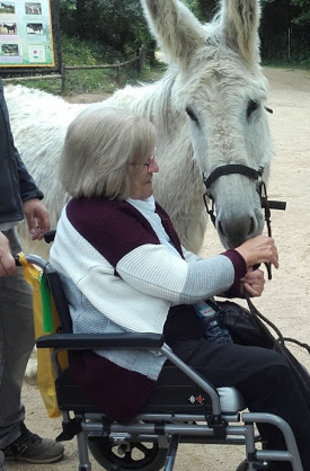From beast of burden to national symbol
Once used as an everyday working animal on farms, the Catalan donkey is now recognised as a highly intelligent animal and has survived thanks to companies offering family activities and games in the countryside
The donkey had to been reinvented decades ago to ensure its survival The authorities “don’t help enough, but are strict applying the rules”
According to an old Catalan saying, there used to be a Joan, a Josep, and a donkey, in every Catalan home. Clearly this is no longer the case, at least where the donkeys are concerned.
This animal, which was indispensable for working the land, had to been reinvented decades ago so as to ensure its survival. Nowadays, it is used in games and activities for the whole family. Various companies have found ways to recover the use of an animal that is otherwise only to be found these days in fairy tales or on TV, or, in the case of Catalonia, a symbol for the country. The donkey known as the burro català, also called ase or ruc, has been living with humans for more than 3,000 years. While often considered a poor relation of the horse, over the centuries donkeys were widely ridden, including by key historical characters, such as Jesus of Nazareth, and in literature, Sancho Panza.
A symbol of the Democratic Party in the US, Juan Ramon Gímenez immortalised the donkey in the children’s tale, Platero y yo, while David Stern gave it a voice in Francis the Talking Mule, which began as a film and became a hit TV series in the 1960s.
Adaptable offerings
The donkey is not stubborn, but highly-determined, says someone who knows this animal really well. After 20 years working with the donkeys in the Rukimon park, in the Canyamars valley in the municipality of Dosrius (Maresme), Paloma Vicente and her partner, Joan Compañó, live with almost 60 donkeys, and offer an extensive catalogue of activities for their visitors. Most visits are from schools, where the little ones often have their first experience with a real donkey; walking them, grooming them and saddling them. Once they pass all the tests, the children get a donkey rider licence. “We are the only reservation in Spain with specimens of all the breeds on the peninsula, and our main objective is the dignification and preservation of this excellent animal,” says Vincente, who sees Rukimon as more than a business, describing it as “a vocation”. Apart from the family activities, the company offers experiences for elderly people, therapies for disabled people, and even activities for company employees, ”aimed to create group dynamics and team building”.
Bring a picnic
Also in the Maresme, this time in Tiana, is the Rucs de la Serralada centre, which opened four years ago. “We’ve got 11 common donkeys that we have been taming and training,” says Carles Muntet, who is in charge of the centre. Hiking is one of the centre’s most popular activities. “We offer
routes we designed to discover the environment through forest tracks and trails in the Serralada de Marina park,” he says, adding that only children are allowed to ride the donkeys, which also carry the picnic baskets.
Muntet feels hurt by the comments from some animal rights groups, which accuse companies like his of exploiting animals. “These are empty criticisms meant to harm, because we look after the donkeys and their health really well,” he says, regretting that the authorities “don’t help enough, but on the other hand, are very strict when it comes to applying the rules.”
Lluís Vilà, from the Rucs i Someres company, located in les Preses (Girona), is a veteran in dealing with donkeys, starting as he did in 1977. He organises walks with the Catalan donkeys through the Pedra Tosca park. “In our centre, we have almost a hundred donkeys, which graze on open pasture,” he says, insisting on the value of this local breed, “considered one of the best in the world.” Vilà, who is also working on a@ project to make cheese from female donkey milk, also calls for more help from the authorities, for a job that “at this moment, is what guarantees the survival of what is in every way, an exceptional animal”
experiences
Els Tres Tombs
Also called la Festa de Sant Antoni, it’s one of the few occasions to see donkeys in the streets. The festivals run from January 17 to October.








